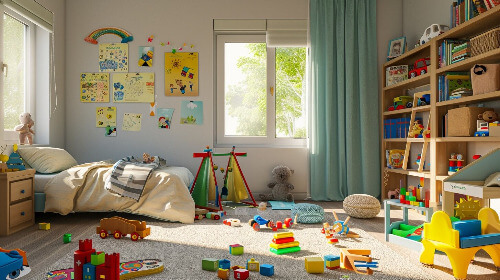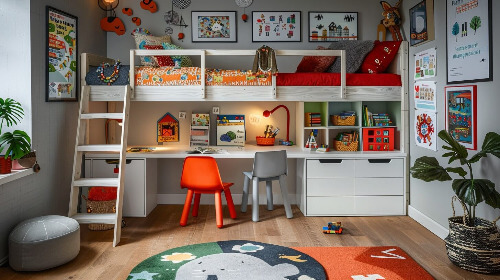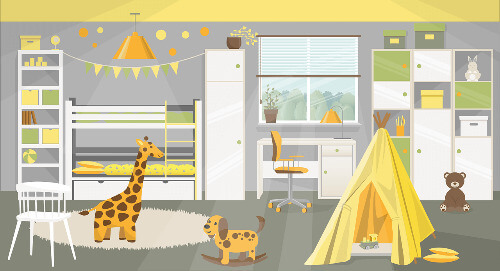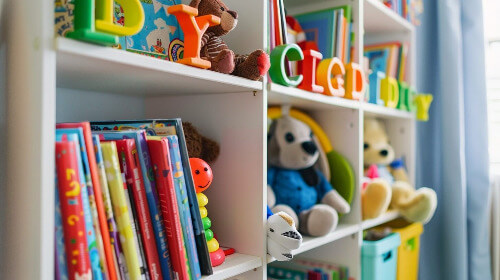A Guide to Choosing Kids Bedroom Furniture
When choosing your kids bedroom furniture, you’re not just picking out a bed or a dresser—you're setting the stage for countless adventures, quiet moments, and a lot of fun memories.
 Child's bedroom with bed in far left corner, a storage shelf on the wall to the right and toys scattered all over the carpeted floor.
Child's bedroom with bed in far left corner, a storage shelf on the wall to the right and toys scattered all over the carpeted floor.You are making sure they have a comfy place to sleep and creating a place to grow, play and dream.
That is one of the reasons why you should let your child have a say in the design and layout of their room. They will feel more connected to their new space and it will encourage their creativity.
Let them choose colors, themes, or even specific pieces of kids bedroom furniture that reflect their interests and personality.
Why Kids Bedroom Furniture Matters
When we think of kids bedroom furniture, it’s easy to focus on the basics: a bed, a dresser, maybe a nightstand.
The choices you make now will affect how your child feels in their space, how easily they can keep it tidy, and how well it adapts as they grow.
Comfort and Safety First
Kids spend a lot of time in their rooms, whether they're sleeping, playing, or doing homework. Ensuring that your kids bedroom furniture is both comfortable and safe is a top priority.
For instance, a bed that supports a good night's sleep is crucial, but it should also have features like rounded edges or guardrails for younger children.
Choose a mattress that is comfortable helping your child get a good nights sleep and it also supports proper posture.
As for the bed frame, low-to-the-ground options are great for toddlers, while older kids might appreciate something a bit higher, especially if it offers under-bed storage.
Also, consider anchoring tall furniture like dressers and bookshelves to the wall to prevent tipping.
Practicality Meets Style
Kids’ rooms should be as practical as they are stylish. Having a place for storage is a good solution for maintaining a tidy space.
Consider kids bedroom furniture that incorporates storage, like beds with drawers underneath, bookshelves, and dressers with plenty of space for clothes and toys.
Multi-functional furniture, such as a bunk bed with a built-in desk or a trundle bed for sleepovers, can also be a smart investment.
 A room setting for an older child. It contains a bunkbed along the front wall, with a desk and 2 chairs underneath and a dresser and storage unit alongside the desk. It also has pictures all over the walls.
A room setting for an older child. It contains a bunkbed along the front wall, with a desk and 2 chairs underneath and a dresser and storage unit alongside the desk. It also has pictures all over the walls.In terms of style, it’s fun to involve your child in the process. Do they have a favorite color or theme? Whether it's dinosaurs, princesses, or a simple color scheme, their input can help make the room feel uniquely theirs.
However, be mindful of choosing kids bedroom furniture that can grow with them. While themed beds might be cute now, neutral pieces offer longevity and can be easily updated with new bedding or decor as their tastes change.
Essential Pieces of Kids Bedroom Furniture
So, what are the must-have pieces when it comes to kids bedroom furniture?
1. The Bed
The bed is the main focus point of any bedroom. Consider your child’s current needs and in what way will those needs change over time.
Toddler beds are great for little ones transitioning from a crib, while twin or full-sized beds might be better suited for older children.
If space is limited, consider a loft bed. Loft beds are elevated, leaving space underneath for a desk, a play area, or storage. This can be a fantastic solution for small bedrooms.
Another space-saving option is a bunk bed if your kids share a room or often have sleepovers.
2. The Dresser
The dresser should complement the overall theme or color scheme of the room.
While it’s tempting to choose something that’s super trendy or matches a particular theme, remember that kids' tastes change quickly. A neutral dresser can adapt to different styles as your child grows.
Safety is always a top priority. Look for dressers with smooth, rounded edges to prevent bumps and bruises. Also, make sure the dresser is stable and consider anchoring it to the wall to prevent tipping.
3. Storage Solutions
Kids have a lot of stuff—clothes, toys, books, and more. By providing dressers, chests and wardrobes you will be giving your kids bedroom furniture that is appropriate to store their clothes and accessories.
Be sure that they are sturdy and any drawers are secure. If your child has lots of books, bookshelves will keep the room organized and make it easy to find the book you or they want to read.
For younger children, lower shelves are ideal for reaching their favorite stories.
Toy storage is another consideration. Bins, baskets, and cubbies can make cleanup easier and can be easily labeled for organization.
4. Nightstand or Bedside Table
A nightstand is a practical addition to any child’s bedroom. It provides a place where they can put their lamp, an alarm clock, or book.
When choosing a nightstand, consider one with a drawer or shelf for extra storage. It’s a small piece of kids bedroom furniture that adds both function and style to the room.
5. A Desk and Chair
As your child grows, a desk becomes more important. It provides a dedicated space for homework, art projects, and creative play.
Choose a desk that suits their current needs but has room to adapt as they get older.
When choosing a chair, think of how user-friendly it is. A chair that supports proper posture can make homework time more comfortable and will help your child concentrate better.
Look for adjustable options that can grow with your child.
Tips for Choosing the Right Kids Bedroom Furniture
Selecting kids bedroom furniture isn’t just about picking what looks good—there are a few other factors to consider to ensure you make the best choice.
1. Think Long-Term
Kids grow quickly, and their tastes change just as fast. While it’s tempting to go all-in on a specific theme, it’s wise to choose furniture that will last through different phases of your child’s life.
That’s why it’s wise to invest in versatile kids bedroom furniture that can adapt as your child grows. Look for pieces that can serve multiple purposes or be easily modified to meet new needs.
Convertible furniture is a great option. For example, cribs that convert into toddler beds or bunk beds that can be separated into twin beds offer flexibility as your child grows.
A dresser with removable changing pads can transition from a nursery essential to a stylish storage solution for an older child.
2. Size and Encouraging Independence
Furniture that encourages independence is a great way to support your child’s development. Choose pieces that they can easily use on their own, like drawers they can reach or bins they can carry.
For example, a child-sized bed allows your little one to climb in and out easily, promoting independence. They will learn to love reading when the books are easily accessible on lower bookshelves.
A desk that’s the right height ensures your child can comfortably do their homework or engage in creative projects.
3. Creativity and Play
 Animated picture of a stuffed giraffe, tent and bunkbed, desk, chair and other toys on the floor and in the storage units, in child's room.
Animated picture of a stuffed giraffe, tent and bunkbed, desk, chair and other toys on the floor and in the storage units, in child's room.A child’s bedroom is not just a place to sleep—it’s a space where they can explore, imagine, and grow. The kids bedroom furniture you choose can play a significant role in encouraging creativity and play.
Include things that inspire imaginative play, like a play tent or a small arts and crafts table. A cozy reading nook with a comfortable chair and a small bookshelf can foster a love of books.
If space allows, a loft bed with a play area underneath can create a fun and functional space for your child to enjoy.
4. Keeping Their Room Tidy & Organized
Encourage your child to participate in keeping their room organized by choosing storage options that are easy for them to use.
Low, open shelving or labeled bins can help them learn to put things away on their own, fostering a sense of responsibility.
5. Budget Considerations
Furnishing a child’s bedroom can be an investment, but it doesn’t have to break the bank. It’s important to balance quality and cost when you are shopping for kids bedroom furniture.
Tempting as it may be to choose the cheaper option, you really are better off to think durability and safety, saving money in the long run.
Making a Space They’ll Love
Remember, your child’s bedroom is their little world, and with the right furniture, it can be a world full of possibilities.


































New! Comments
Have your say about what you just read! Leave me a comment in the box below.